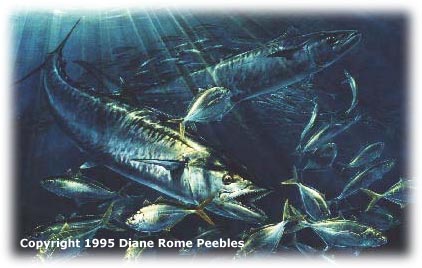The Kingfish By Buck Davidson The wheeling birds have been visible for about a mile now, but as you approach the flurry of activity beneath them, you take note of the strange sound made by thousands of baitfish fleeing the unknown predator below. The churning water and screaming birds assault your senses as your guide allows the boat to drift within casting distance of the melee. Your sardine barely hits the water and you are confronted by a sight which will burn itself into your memory forever. A five foot long fish catapults itself skyward, easily six feet in the air, and its glistening body seems almost snakelike as it crashes downward on your hapless bait. You set the hook almost in self- defense, as line sizzles from your reel at a speed beyond belief. A movement elsewhere in the boat catches your eye, and you turn to see your two companions in a similar fix. The next 30 minutes or so will challenge your angling skills and teamwork as you and your guide attempt to land a triple header of the toothy speed merchants of the Gulf coastal waters during fall and winter: king mackerel. You will rarely hear a local fishermen talk about “King Mackerel”. Around here, the term used is Kingfish or simply kings. Further, large fish in the 25 plus pound range are called smokers, referring either to the preferred method of cooking or to what their first powerful run does to the average reel. Smaller school kings are called snakes, and do take on a definite serpentine look when chasing bait. Kings tend to hunt in schools, herding bait into a small area - baitfish often try to hide behind each other, with the resulting formation of a tightly packed “ball” of bait. Kings slash into this group from below, using the water’s surface as a barrier to prevent or slow their prey’s escape. To further confuse their future dinner, kings will go aerial - attacking bait from above. Prey that is not eaten is severely wounded by the king’s sharp teeth, and makes for an easy catch the next time past. Kingfish are found in Suncoast waters year-round, but catches made during summer are sporadic at best - the fish migrate far offshore to spawn. The annual northern migration of these critters is a big-time angling event here on the Suncoast. The cooling waters in October and early November signals the start of the King’s “run”. Fishermen cruise the Gulf, trolling spoons and plugs and watching for birds. Birds, of course, will hover above the scene of the carnage - plucking whatever morsel they can from the surface - and are a dead giveaway to the kings’ location. Important native tip: Do not troll through the middle of the activity. Oh, you may hook one alright, but you’ll certainly send the school down and off the feed. You will also likely draw a verbal barrage from any other fishermen in the area. The school will stick around for several minutes if worked carefully - sometimes longer. Troll around the edges or drift to within casting range. Tackle for Kingfish needs to have some backbone. A 7 to 8 foot rod is good for casting, while shorter, stouter rods are employed for trolling. When casting for kings, the Ambassadeur 5500, 6500 and 7000 C series baitcasting reels are often used - they have the line capacity needed to handle that first long run. If the fish are running big, though, you may still get your spool cleaned - Kings of 40 pounds are considered bragging-size, with a 50 pounder being a truly special catch. Kings are regularly taken on light tackle - 12 pound test will handle most fish, provided a wire leader is used to protect against those formidable choppers. Keep in mind, lighter line means more line on the spool - more insurance against spool cleanings. It should go without saying that if your drag system is sticky or unreliable - you’re in for a frustrating day. Smooth drags are a necessity to beat these guys. Spoons and several types of plugs are good artificials for kings, with sardines being the live bait of choice. Hook the bait in the belly if you are casting, but through the nose if trolling - he’ll stay alive a lot longer and swim more naturally. The Kingfish run was almost non-existent several years ago. This in stark contrast to the days when it was possible to catch kings using only a landing net dipped among the thrashing bait - yes that’s a true story. When the fish moved offshore, they were easy prey for netters and high-tech purse seining ships, which were capable of catching entire schools. When the survivors made it back inshore, they were greeted by a sport fishery upon which no bag limits were placed - the heavy pressure from both sides took its toll. Bag limits and commercial quotas have been established, and the last few years have seen the return of some nice schools of kings. The fishery is not what it once was, but has been on the rise recently. This could very well be another fisheries management success story in the making. The bag and size limit changes occasionally, so be sure to check them before you go fishing (click here) Buck |
Florida Saltwater Fishing in the Gulf of Mexico



